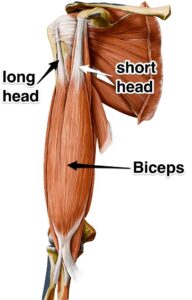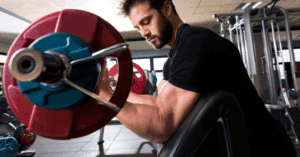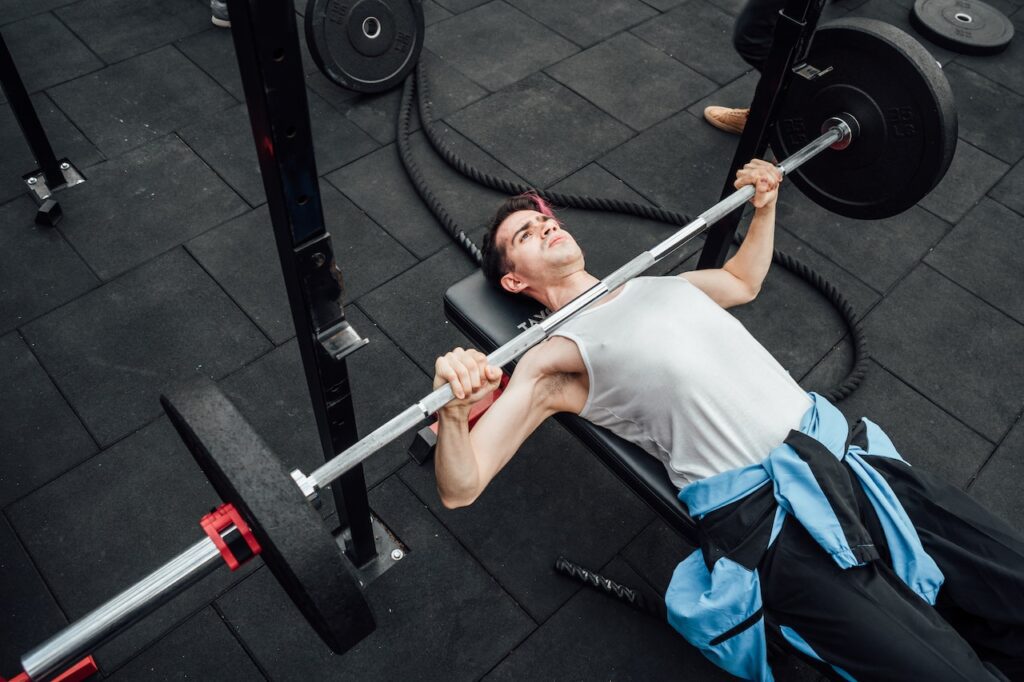Unveiling the truth about bicep development: Does bench press work biceps? Dive into the mechanics of the bench press, explore bicep involvement, and debunk the myth. Discover effective exercises to specifically target the biceps and achieve optimal upper body strength.
When it comes to the realm of weightlifting, the bench press holds a revered status as a foundational exercise for fostering strength in the upper body. However, an enduring debate revolves around does bench press work biceps?
Within this blog post, we shall delve into the mechanics of the bench press, scrutinize the involvement of the biceps, and dispel any misconceptions regarding its impact on bicep development.
Unravelling the Mechanics of the Bench Press:
The bench press, an amalgamation of movement, stands as a compound exercise primarily targeting the pectoral muscles, shoulders, and triceps. This exercise entails reclining on a bench and propelling a weighted barbell away from the chest, employing both arms. While the primary focus lies on targeting the chest muscles, other muscle groups act as auxiliary components, supporting this movement.
While executing the bench press, the pectoralis major, anterior deltoids and triceps brachii seamlessly collaborate, harmonizing their efforts to generate force and move the weight. Yet, it is important to acknowledge that the biceps also play a role during this exercise. So, the question arises does bench press work biceps?
The Biceps and Their Contribution to the Bench Press:
Although the bench press predominantly targets the chest and triceps, the biceps do make their presence felt within the movement. As the barbell descends toward the chest, the biceps serve as stabilizers, exerting influence over the controlled descent. During the subsequent pressing phase, they assist the triceps in extending the arms and reinstating the weight to its initial position.
Nevertheless, it is crucial to comprehend that the level of bicep involvement in the bench press is minimal in comparison to exercises that explicitly target the biceps. The bench press primarily centres its attention on fostering the growth of the chest and triceps.
Anatomy of Bicep Muscle:

By understanding the anatomy of the bicep muscle we’ll be able to answer the popular question ” Does bench press work biceps”? The Bicep has a long and thick muscle named Brachii on the ventral portion of the upper arm. It constitutes of two heads: The Long head and The Short head.
The long head activates in movements when you move your arm in a neutral position i.e. thumb pointing upwards. While the short head activates when you move your arm in a way that your palm is pointing towards the ceiling.
The long head of bicep is thicker than the short head and it constitutes most of the bicep but, the importance of the short head of bicep can’t be ignored as it helps in forearm supination. There’s also a muscle named brachialis that is located beneath the bicep and helps in forearm flexion.
Does Bench Press Work Biceps? Dispelling the Myth:

Does Bench Press work biceps or does it induce bicep growth? In contrast to the widely held belief, the bench press does not constitute a direct bicep exercise. Its fundamental focus rests upon nurturing the chest, shoulders, and triceps.
Although the biceps experience some degree of activation due to their role in stabilizing and supporting the movement, they do not represent the primary target of this exercise.
To cultivate well-defined biceps, it becomes imperative to incorporate specific exercises that directly stimulate and isolate the biceps. So hopefully when someone asks” Does bench press work biceps”? you would be able to answer it quite efficiently.
Factors Influencing Bicep Engagement during the Bench Press:
1-The Influence of Grip Width:
The width of one’s grip during the bench press governs the recruitment of various muscle groups. A wider grip predominantly emphasizes the chest and triceps, while a narrower grip may augment bicep involvement to some extent. Experimenting with different grip widths allows individuals to ascertain the variant that aligns with their goals and personal preferences.
2-Range of Motion and its Effect on Bicep Recruitment:
The range of motion executed during the bench press plays a pivotal role in activating the biceps. Exercises with a shorter range of motion, such as the partial bench press, might curtail bicep recruitment compared to exercises that encompass a full range of motion. Engaging in the bench press through its complete range of motion permits greater bicep engagement.
3-Technique and the Activation of Biceps:
Optimizing one’s technique proves indispensable in maximizing bicep activation during the bench press. Prioritizing the preservation of tension in the biceps throughout the movement, firmly gripping the bar, and adhering to proper form can augment bicep activation. Additionally, fostering a mind-muscle connection by consciously engaging the biceps amplifies their involvement in the exercise.
Supplementary Exercises for Bicep Development:
In order to attain comprehensive bicep development, it becomes imperative to incorporate exercises specifically tailored to target the biceps within one’s workout regimen. The following exercises prove effective in this pursuit:
1-Bicep Curls:

Bicep curls represent a timeless exercise that isolates the biceps. One can execute this exercise using dumbbells, barbells, or cables. Emphasize controlled movements, exert a firm squeeze at the pinnacle of the curl, and ensure adherence to proper form.
2-Hammer Curls:

Hammer curls direct their focus towards the biceps and the brachialis, a muscle nestled beneath the biceps. Adopt a neutral grip (palms facing each other) while grasping the dumbbells and execute the curling motion.
3-Preacher Curls:

Preacher curls distinctly concentrate on the biceps by stabilizing the upper arm and isolating the elbow flexors. Employ a preacher bench and perform curls utilizing either dumbbells or a barbell.
4-Chin-ups:

Chin-ups serve as a compound exercise primarily targeting the back muscles, while simultaneously heavily involving the biceps. Grasp a bar with an underhand grip (palms facing towards you) and elevate your body until your chin surpasses the bar.
By incorporating these exercises into one’s routine, individuals can directly stimulate the biceps, facilitating their growth and strength.
Frequently Asked Questions (FAQ):
Q1: Can the bench press alone foster the development of well-defined biceps?
Solely relying on the bench press is inadequate for the cultivation of well-defined biceps. The inclusion of targeted bicep exercises proves indispensable in fully stimulating and developing the biceps.
Q2: Should I incorporate bicep exercises if I already engage in bench press?
Yes, it is advisable to integrate bicep exercises into one’s routine to ensure balanced upper body development and optimize bicep growth. While the bench press engages the biceps to some extent, dedicated bicep exercises offer focused stimulation.
Q3: Is it possible to augment bicep engagement during the bench press?
While the bench press primarily concentrates on the chest and triceps, adjusting grip width and adhering to proper form can enhance bicep activation to a certain degree. However, to maximize bicep growth, it is advisable to include exercises that specifically target the biceps.
Q4: What alternative exercises exist to target the biceps besides the bench press?
Alternative exercises that directly target the biceps encompass bicep curls, hammer curls, preacher curls, and chin-ups. Incorporating these exercises into one’s routine facilitates direct and targeted stimulation of the biceps, fostering their growth and strength.
Conclusion:
In conclusion, the bench press emerges as a valuable compound exercise for cultivating upper body strength. Nevertheless, it should be noted that the bench press does not represent a direct bicep exercise. To foster well-defined and developed biceps, the integration of targeted exercises that isolate and stimulate the biceps is imperative.
By incorporating exercises such as bicep curls, hammer curls, preacher curls, and chin-ups into one’s workout routine, individuals can directly stimulate the biceps, complementing the advantages of the bench press and promoting balanced development of the upper body.
Remember, adopting a comprehensive approach to strength training that combines compound exercises like the bench press with targeted activities tailored to specific muscle groups yields optimal results in achieving one’s desired physique. I hope this will help you answer the question, does bench press work biceps?
We extend our gratitude for your readership. We hope this blog post has furnished valuable insights into the correlation between bench press and bicep development, debunking misconceptions, guiding you towards an informed approach to your fitness journey and answering the question Does bench press work biceps. Should you require further elucidation or additional information, please do not hesitate to contact us. Best of luck with your weightlifting endeavours!
Hello, fellow fitness enthusiasts! I'm Zayn, a Board Certified Fitness and Nutrition Coach. My journey started from a personal commitment to fitness, and over time, this passion ignited a desire to help others unlock their potential. I transformed this passion into my profession, and today, I'm proud to say that I am armed with a plethora of certifications, all testament to my dedication and commitment.
When I'm not advising clients or working on my next blog post, you'll find me trying out new fitness regimes, diving into the latest nutritional research, or practicing what I preach with my own healthy lifestyle. My mission is to help you become the best version of yourself, showing that fitness and nutrition are as much about the journey as they are about the destination.


